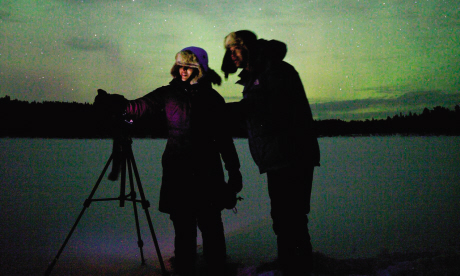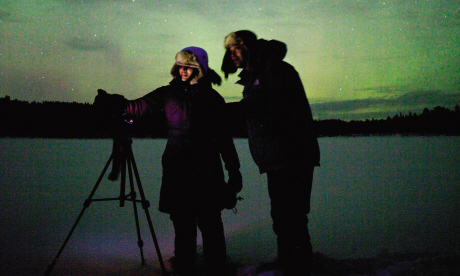
How do you capture the magic of the aurora borealis on camera? Amateur snapper Nick Boulos learned from the pros on a sub-zero photo safari in Finland
Like a vision, she came in the dead of night and stole my heart. Until that fateful hour, ours had always been a tempestuous relationship. We’d got off to a good start one evening in Iceland some years ago, but that encounter lasted just seconds: a premature finish brought things to an abrupt end. Rendezvous followed in Canada and Norway, though both were lacklustre and ended in disappointment. It was the usual story: I wasn’t patient enough; she wasn’t in the mood.
Like most women, she’s mysterious and unpredictable; some may say she’s a diva. Her name is Aurora.
The mesmerising northern lights – or aurora borealis to give the phenomenon its scientific and more poetic name – have captivated, enchanted and evaded people (including me) for centuries. But I was giving Aurora and I one last stab at happiness.
I arrived in Finnish Lapland with high hopes. And I wanted a lasting reminder of our special time together. So I sought the help of an expert: pro photographer and self-proclaimed ‘aurora hunter’ Andy Keen, who leads northern lights safaris from the town of Ivalo, high above the Arctic Circle.
Andy heralds from Merseyside. Aged 20, he was struck by a neurological disorder and left paralysed from the waist down. But he defied doctors by making a recovery, learning to walk again and training as a civil engineer.
Then he fell victim to the Lumley effect. One evening he watched a documentary in which actor Joanna realised her childhood dream of seeing the northern lights.
“I couldn’t take my eyes off the screen,” recounted Andy. A trip to Norway quickly followed. “I lay in the snow and just watched the lights dance. I was hooked. When I eventually picked myself up off the floor and tried to take a photo, I left the lens cap on.”
A year later, in 2009, he relocated to Lapland. The rest is history.
“You don’t need to spend thousands on expensive gear,” Andy declared reassuringly as our group of eight prepared to set off on the first of three nights aurora hunting.
“I’ve seen some great results from decent compact digitals.”
I was packing a Canon 400D and 18-55mm lens: nothing fancy but reliable and certainly capable of capturing the magic. “The biggest challenges are the elements and your own reactions. You only have a few seconds of opportunity to get the shot,” added Andy.
Anticipation was running high as we drove out of town, past Lapland’s only speed camera and a man walking his husky. The haze of Ivalo’s light pollution soon filtered away, revealing a starry abyss above.
With one eye on the road and the other forever peering skyward, Andy followed the deserted Arctic Ocean Road north to the Russian border, 55km away. To maximise the odds of success, Andy checks hourly satellite images to predict weather patterns and cloud cover and thinks nothing of travelling vast distances. “Last week I drove 3,000km, looking for breaks in the clouds,” he said.
Before long, we swerved into a roadside clearing. An icy blast burst into the car as we piled out, juggling wire, tripods and woolly hats. Suspended in the air, and perfectly framed by the spindly silhouettes of birch trees, were the northern lights.
The aurora had taken the form of a pale-green seashell; it swirled slowly in the darkness. The colours intensified slightly, and its speed picked up, creating an effect known in the trade as ‘pencilling’.
A sense of unbridled glee rushed through my body. Unable to speak or even blink, I didn’t think about taking a photo. Suddenly, as though somebody had cruelly flicked the light switch, the aurora vanished. Gone, like she had never been there at all.
“Right everyone, hop in. We’re going to Russia,” exclaimed Andy, whose passion for the aurora knows no borders.
Russia appeared on the other side of a long and narrow bridge, beyond a small snow-capped island in the middle of a partly frozen river. There wasn’t a person or building in sight. Patches of whispery cloud drifted by, allowing the northern lights to shine sweetly, sweeping bands that swelled and stretched across the night sky.
Andy rushed around checking camera settings, identifying constellations, pointing out planets and telling the odd dodgy joke as we snapped away. “Avoid checking each shot to preserve your camera battery. I always turn my review function off,” he advised.
“That’s because you know what you’re doing,” I replied. I took photo after photo, tweaking shutter speeds and ISO settings, and changing locations to find the perfect foreground – an important part of northern lights photography. I alternated between the water’s inky surface, which reflected the glowing lights, and the tree-lined riverbanks illuminated by the moon.
It was 4am by the time I got to bed: Andy's tours rarely return before 2am

Heading back – after a warming hot chocolate in the woods – everyone reviewed the fruits of their labours. Impressive images of vivid greens etched across snowy backdrops were proudly shared, but my efforts were blurry, dull and grainy. Acute disappointment set in, along with the realisation that northern lights photography is a rather deceiving business. The extended amount of light pouring into the lens means the lights are often depicted as much brighter and more saturated than they appear to the naked eye.
It was 4am by the time I climbed into bed (Andy’s tours rarely return before 2am). I was frustrated, but also exhilarated by my evening with Aurora – and impatient for our second date.
Given the extremely late nights, days are left at your disposal. There are many ways to pass the time – from hanging out with huskies to speeding on snowmobiles and strolling on snowshoes – but all are merely preludes to the main attraction when darkness finally descends.
However, I spent an enjoyable afternoon travelling through a fairytale winter wonderland in a horse-drawn sleigh to a Sami wilderness church near the town of Inari, further north. Taking the reins of our horses were Esko, a certified Santa Claus during Lapland’s busy festive period, and Stau, whose other occupations included painter and fortune-teller. Sitting on bales of grass under warm reindeer skin, we crossed a vast frozen lake and a patch of woodland strewn with giant boulders from the Ice Age, finally arriving at the deserted wooden church of Pielpajärvi.
Opening the wooden shutters, sunlight flooded in, illuminating the rustic 18th-century interior of narrow, cramped pews and a small pulpit. The Sami, Lapland’s original settlers, were clearly a petite bunch. Services here originally lasted a week during the bitter winter months but I could barely manage a few minutes sitting with my knees pressed up against the row in front.
Like most indigenous communities in the Arctic, the Sami had their theories about the northern lights. They believed the spectacle was the work of a mythical firefox whose tail brushed colourful sparks into the sky. (The more prosaic scientific explanation is that they’re caused by charged particles from the sun colliding with the earth’s atmosphere.)
Outside, herbal tea infused with sprigs of wild plants, plucked from nearby bushes, bubbled on an open fire. But I found myself wishing away the minutes, aching for night to fall. Conditions were perfect: the air was cold and crisp, the sky clear – but was Aurora in the mood to play?
That night we spurned Russia and travelled north-west towards Norway instead. Our first port of call was another secluded waterside location, this time with a solitary cabin perched on the snowy shoreline.
Above us, the sky was draped in a translucent veil through which shooting stars chased. Andy took a test shot; it came back green. Aurora was all around us. “It’s building,” he said theatrically. “We just have to be patient.”
Determined to improve my photography, I set to work framing my shots and experimenting with the focus and various settings. It started to pay off: some lovely Arctic scenes – snowy vistas beneath vibrant green bands of light – flashed across my camera screen.
Conversation turned to the recent solar flare on the sun’s surface, which sparked extraordinary displays. “There was talk around here that it would effect phone signals and washing machines,” said Andy. “It wreaked havoc with the ATMs.”
Nearly three hours later, we moved on to the banks of a frozen river. Clambering over a barbed-wire fence and scrambling down an embankment of knee-deep snow, we emerged onto a sparkling runway that snaked out of view into the distance. Aurora was there to greet us. To one side, she formed tornado-esque spirals and shapes resembling a flickering flame; over my shoulder, a giant horseshoe formation was fast gaining colour and intensity.
I snapped frenziedly, like a paparazzo with the scoop of the century. Then I saw red. Not in the sky, but in my viewfinder. The cold had drained my batteries just as an emerald rainbow stretched from one end of the horizon to the other.
My despair was shortlived, thanks to Andy – he stepped forward clutching his top-of-the-range camera (and £1,200 Carl Zeiss lens). “Put your memory card in here and keep going,” he said kindly.
Adrenalin kept me warm despite the falling temperatures (-8°C and plummeting), as did the never-ending visual dramatics – a soap opera of twists and turns directed by Mother Nature herself. At 2am, two numb feet and countless photos later, we began to pack away – just as Aurora flared up once again. “She’s teasing us,” I said.
At the van, it was much-needed hot chocolates all round. I gazed intently at the vast arc above. It had started to splinter, with fast-moving darker strands appearing like tears in a reel of smooth silk. At the far end of the road, a column of bright light soared high. All was calm but there was an indescribable energy brewing under the surface.
In a flash, the sky erupted in a blaze of green and the softest of blues. Dancing like a teenager and almost touching the treetops, rows of rippling curtains with specks of pink on the fringes consumed the entire scene. Andy and I glanced at each other. Instinctively, I grabbed the camera and together we sprinted up the icy road and waded through waist-deep snow to capture the moment.
Frantically framing the shot, I took a 30-second exposure, giving me enough time to simply savour the moment. Craning my neck, I stared directly above.
Time seemed to slow, almost to a stop. Pouring down like fairy dust, the somersaulting spirals nearly wrapped themselves around me – so close, I felt sure I could reach out and touch them. A lump formed in my throat at the sheer beauty of what was unfolding. It was as though Aurora was whispering my name, as though this whole display was just for me...
 An amateur's aurora album: take a look at shot's from Nick's trip and see how he improved here
An amateur's aurora album: take a look at shot's from Nick's trip and see how he improved here